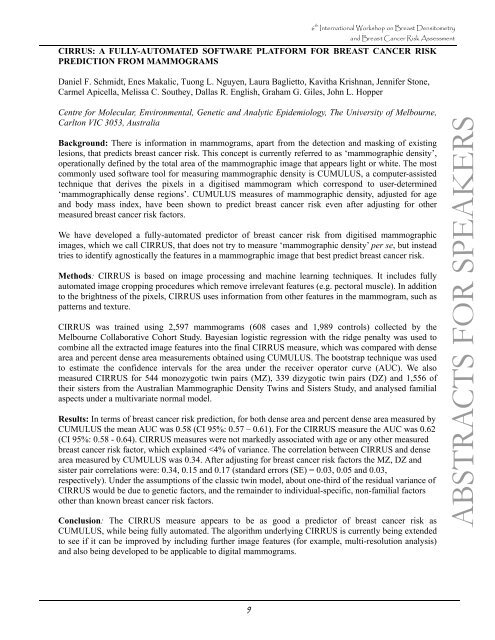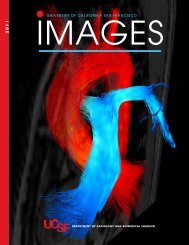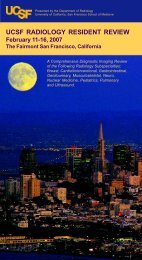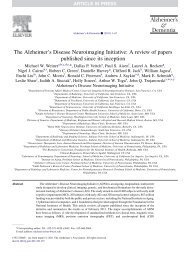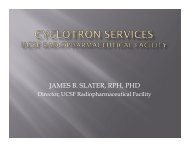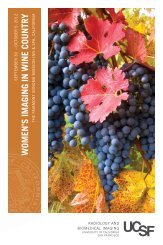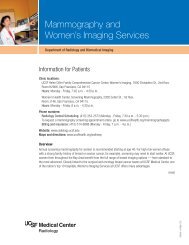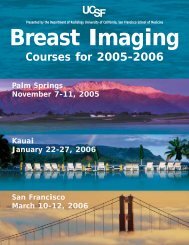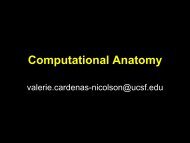6th International Workshop on Breast Densitometry and Breast ...
6th International Workshop on Breast Densitometry and Breast ...
6th International Workshop on Breast Densitometry and Breast ...
- No tags were found...
You also want an ePaper? Increase the reach of your titles
YUMPU automatically turns print PDFs into web optimized ePapers that Google loves.
6 th <str<strong>on</strong>g>Internati<strong>on</strong>al</str<strong>on</strong>g> <str<strong>on</strong>g>Workshop</str<strong>on</strong>g> <strong>on</strong> <strong>Breast</strong> <strong>Densitometry</strong><br />
<strong>and</strong> <strong>Breast</strong> Cancer Risk Assessment<br />
CIRRUS: A FULLY-AUTOMATED SOFTWARE PLATFORM FOR BREAST CANCER RISK<br />
PREDICTION FROM MAMMOGRAMS<br />
Daniel F. Schmidt, Enes Makalic, Tu<strong>on</strong>g L. Nguyen, Laura Baglietto, Kavitha Krishnan, Jennifer St<strong>on</strong>e,<br />
Carmel Apicella, Melissa C. Southey, Dallas R. English, Graham G. Giles, John L. Hopper<br />
Centre for Molecular, Envir<strong>on</strong>mental, Genetic <strong>and</strong> Analytic Epidemiology, The University of Melbourne,<br />
Carlt<strong>on</strong> VIC 3053, Australia<br />
Background: There is informati<strong>on</strong> in mammograms, apart from the detecti<strong>on</strong> <strong>and</strong> masking of existing<br />
lesi<strong>on</strong>s, that predicts breast cancer risk. This c<strong>on</strong>cept is currently referred to as ‘mammographic density’,<br />
operati<strong>on</strong>ally defined by the total area of the mammographic image that appears light or white. The most<br />
comm<strong>on</strong>ly used software tool for measuring mammographic density is CUMULUS, a computer-assisted<br />
technique that derives the pixels in a digitised mammogram which corresp<strong>on</strong>d to user-determined<br />
‘mammographically dense regi<strong>on</strong>s’. CUMULUS measures of mammographic density, adjusted for age<br />
<strong>and</strong> body mass index, have been shown to predict breast cancer risk even after adjusting for other<br />
measured breast cancer risk factors.<br />
We have developed a fully-automated predictor of breast cancer risk from digitised mammographic<br />
images, which we call CIRRUS, that does not try to measure ‘mammographic density’ per se, but instead<br />
tries to identify agnostically the features in a mammographic image that best predict breast cancer risk.<br />
Methods: CIRRUS is based <strong>on</strong> image processing <strong>and</strong> machine learning techniques. It includes fully<br />
automated image cropping procedures which remove irrelevant features (e.g. pectoral muscle). In additi<strong>on</strong><br />
to the brightness of the pixels, CIRRUS uses informati<strong>on</strong> from other features in the mammogram, such as<br />
patterns <strong>and</strong> texture.<br />
CIRRUS was trained using 2,597 mammograms (608 cases <strong>and</strong> 1,989 c<strong>on</strong>trols) collected by the<br />
Melbourne Collaborative Cohort Study. Bayesian logistic regressi<strong>on</strong> with the ridge penalty was used to<br />
combine all the extracted image features into the final CIRRUS measure, which was compared with dense<br />
area <strong>and</strong> percent dense area measurements obtained using CUMULUS. The bootstrap technique was used<br />
to estimate the c<strong>on</strong>fidence intervals for the area under the receiver operator curve (AUC). We also<br />
measured CIRRUS for 544 m<strong>on</strong>ozygotic twin pairs (MZ), 339 dizygotic twin pairs (DZ) <strong>and</strong> 1,556 of<br />
their sisters from the Australian Mammographic Density Twins <strong>and</strong> Sisters Study, <strong>and</strong> analysed familial<br />
aspects under a multivariate normal model.<br />
Results: In terms of breast cancer risk predicti<strong>on</strong>, for both dense area <strong>and</strong> percent dense area measured by<br />
CUMULUS the mean AUC was 0.58 (CI 95%: 0.57 – 0.61). For the CIRRUS measure the AUC was 0.62<br />
(CI 95%: 0.58 - 0.64). CIRRUS measures were not markedly associated with age or any other measured<br />
breast cancer risk factor, which explained


